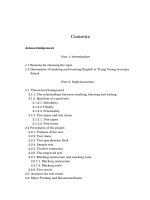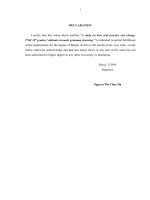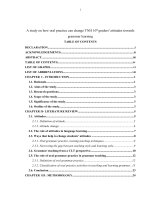A study on employee work life balance as an HR imperative
Bạn đang xem bản rút gọn của tài liệu. Xem và tải ngay bản đầy đủ của tài liệu tại đây (247.87 KB, 6 trang )
International Journal of Management (IJM)
Volume 11, Issue 2, February 2020, pp. 271–276, Article ID: IJM_11_02_028
Available online at />Journal Impact Factor (2020): 10.1471 (Calculated by GISI) www.jifactor.com
ISSN Print: 0976-6502 and ISSN Online: 0976-6510
© IAEME Publication
Scopus Indexed
A STUDY ON EMPLOYEE WORK LIFE
BALANCE AS AN HR IMPERATIVE
Magdalene Peter
Assistant Professor, Department of Management Studies, Bharath Institute of Higher
Education and Research, Chennai, India
Dr. S. Fabiyola Kavitha
Associate Professor, SRM Arts and Science College, Trichy, India
ABSTRACT
There is a growing awareness in today's workplaces that employees do not give up
their lives just because they work. Work and life remain the two most important
domains in the life of an employed individual. However, the challenge of balancing
work and non-work demands is one of today's central concerns for both individuals
and organisations. With the growing diversity of family structures represented in
today‟s workforce, particularly with the growing norm of dual-career families, the
importance of managing an employee's work-life balance have increased markedly
over the past 20 years. Employers are realising that the quality of an employee's
personal and family life impacts work quality and that there are concrete business
reasons to promote work and non-work integration. In this paper, we contend that
assisting employees to achieve a work-life balance should become a critical part of
HR policy and strategy if it is to truly get the best from the organisation's people
without leaving them unsatisfied, burnt-out and unfulfilled.
Key words: Work-life balance, Human resources, Employee, Organization
Cite this Article: Magdalene Peter and Dr.S.Fabiyola Kavitha, a Study on Employee
Work Life Balance as an Hr Imperative, International Journal of Management (IJM),
11 (2), 2020, pp. 271–276.
/>
1. INTRODUCTON
1.1. PERFORMANCE APPRAISAL
Execution evaluation is a technique by which the presentation of a representative is estimated
(by and large as far as quality, amount, cost and Time). The underlying foundations of
Performance Appraisal can be found in Frederick Winslow Taylor's time and movement
study. Execution examination is a piece of vocation improvement.
/>
271
Magdalene Peter and Dr.S.Fabiyola Kavitha
1.2. REQUIRE FOR THE STUDY
a.
b.
c.
d.
e.
f.
Self-advancement and individual directing.
Organized preparing and advancement.
Team building.
Performance the board.
Strategic or association advancement.
Validation of preparing and different activities.
1.3. SCOPE OF THE STUDY
The accompanying four powers have energized the quick development of 360-degree input in
the ongoing years:
Changes in the jobs of the representative and what the association expects of the worker,
for example, consolation given to joint effort and group working, ceaseless upgrades, decrease
in representative numbers and levels of the executives, adaptability and so on.
1.4. LIMITATIONS OF THE STUDY
In spite of the fact that the exploration turned into achieved in an orderly and organized way,
there were multiple limitations that couldn't be survived. These comprised the restrictions of
the examination. Care turned into taken that the below constraints didn't have an effect on the
exploration outcomes to such an extent. Time vital was the finest confinement. The task have
to be completed inside three months and thus the example size have to be lesser. Area
determination ought to be achieved on an irregular premise. In a few instances supervisors
were now not prepared it supply the data. One trouble that each questioner faces is the
readiness of the customers in topping off the survey. The respondents have some secret issues
over the organization. Along those lines, it is difficult to find out the belief precisely. The
impact of the contenders can't be predicted by methods for this investigation.
1.5. OBJECTIVES OF THE STUDY
1.5.1. PRIMARY OBJECTIVE
• To compare the overall performance of employees.
• To compare the performance of the organization. The components of the look at
includes:
• Determining employee’s contribution & commitment towards overall performance
appraisal system.
• Determining the steps taken with the aid of the enterprise to perform the
performance appraisal. Determining the effectiveness of steps taken to carry out
the performance appraisal. Research
2. METHODOLOGY
The exam strategy applied for the exploration object is wonderful in nature. The populace for
this research is large scope IT companies in Chennai. In this way the exam has performed on
evaluation study. A rundown of sizeable IT businesses (just open constrained) running in
Chennai(223) become readied and these corporations were stratified into Application
programming, Client server, E-Commerce, Embedded/EDA/VLSI/ASIC/Chip Design,
Software programming, Mainframe, ERP/CRM, DBA/Warehousing, QA/Testing, Network
Admin/Security and Tech support/Telecom/Hardware. In view of judgment and inferable
/>
272
A Study on Employee Work Life Balance as an Hr Imperative
from time requirement the professional outstanding one hundred thirty employees for man or
woman meetings. The degrees of those workers are General Manager, Assistant Manager and
Manager. Right now facts is straightforwardly amassed from directors with the help of
booked surveys and meeting approach separately. The professional has likewise amassed
information from auxiliary sources. A part of the auxiliary sources are: Websites Magazines
Books
TABLE 1 TABLE VIEWING HOW THE WORKERS DISCOVER THE WORK
S.NO
1.
2.
3.
4.
NO OF
RESPONDENTS
34
62
27
7
130
CHOICE
Outstanding
Good Quality
Pleased
Awful
TOTAL
PERCENTAGE (%)
26.15
47.69
20.77
5.38
100
SOURCE: PRIMARY DATA
INFERENCE:
47.69% of the personnel locate the job to be good, 26.15% of the personnel reveals the job to
be excellent, 20.77% of the employees are satisfied with the task whereas in few cases the
personnel finds the task to be bad.
CHART SHOWING HOW DO THE EMPLOYEES FIND THE JOB
5%
26%
21%
EXCELLENT
GOOD
SATISFIED
BAD
48%
Chart 1
TABLE 2 TABLE PRESENTATION WHETHER THE WORKER REQUIRE PREPARATION
S.NO
1.
2.
OPTIONS
YES
NO
TOTAL
NO OF
RESPONDENTS
90
40
130
PERCENTAGE (%)
69.2
30.8
100
SOURCE: PRIMARY DATA
/>
273
Magdalene Peter and Dr.S.Fabiyola Kavitha
INFERENCE:
69.2% of the member of staff need teaching whereas 30.8% of the worker does not teaching.
CHART SHOWING WHETHER THE EMPLOYEE NEED TRAINING
31%
YES
NO
69%
.
Chart 2
3. FINDINGS OF THE STUDY
•
•
•
•
•
•
•
•
•
If the employee is asked to work alone 44.6% of the employees sometimes excel,
36.9% of the employees will always excel, 10.8% will often excel whereas in few
cases the employee never excel.
If the employee is made part of a team, 45.39% of the employees will always get
things done, 29.23% may get the things done18.46% will often get the things done
whereas in few cases the employee never get things done.
47.69% of the employees find the job to be good, 26.15% finds the job to be
excellent, 20.77% are satisfied with the job whereas in few cases the employees
finds the job to be bad.
If the employee asked to work alone 45.39% of the employees will always excel,
29.23% will sometimes excel, 18.46% will often excel whereas in few cases the
employee never excel.
69.2% of the employee need training whereas 30.8% of the employee does not
training.
32.31% of the superiors never allocate the work which are highly confidential,
27.69% always allocate the work, 21.54% will sometimes allocate whereas in few
cases the superiors often allocate the work which are highly confidential.
51.54% of the employees get on with others in the company, outstanding
relationship is only 28.46% and unsatisfactory is 20%.
32.31% of the abilities can never be better utilized, 27.69% can always be better
utilized, and 21.54% can be sometimes utilized whereas in few cases it is often.
36.92% of the employees will sometimes accept responsibility for decisions,
23.08% will often & always accept the responsibility whereas in few cases it is
never.
/>
274
A Study on Employee Work Life Balance as an Hr Imperative
•
•
•
•
•
•
•
•
•
•
•
•
•
•
•
•
•
The ratings of the employee assessment questionnaire for the particular factors are
mostly sometimes, in some cases it is always whereas in few cases it is never in
case of all the factors of employee assessment questionnaire.
36.92% of the employees will sometimes analyze and identify the problems,
31.54% will always analyze and identify the problems, and 22.31% will often do
the job, whereas in few cases it is never.
44.6% of the employees will sometimes identify the possible causes of problems
and takes corrective action, 36.9% will always identify, and 10.8% will often do
the job whereas in few cases it is never.
44.62% of the employees sometimes plan responsibly for departmental budgeted
areas, 29.23% will always plan, and 16.92% will often plan whereas in few cases it
is never.
30.77% of the employees always make difficult commitments, 29.23% sometimes
make difficult commitments, and 28.46% often make it whereas in few cases it is
never.
36.92% of the employees sometimes report on internal customer satisfaction,
23.08% will often and always report whereas in few cases it is never.
52.31% of the employees sometimes identify the customer needs, 30.77% will
often identifies, and 9.23% will never do the job whereas in few cases it is never.
38.46% of the employees never listen to problems with genuine interest, 36.92%
sometimes listens with genuine interest, and 30.77% will always listen whereas in
few cases it is never.
34.62% of the employees often encourages the free expression of opinions without
being defensive, 33.85% always encourages, 28.46% sometimes encourages
whereas in few cases it is never.
36.92% of the employee’s decisions often balance company’s profitability and
customer needs, 34.62% always balance, and 19.23% sometimes balance whereas
in few cases it is never.
40.77% of the employees always select good people, 37.69% often select good
people, 16.15% sometimes excel whereas in few cases it is never.
35.38% of the employees will often train and develop employees, 32.31% will
always train, and 24.62% will sometimes train whereas in few cases it is never.
49.23% of the employees always conduct staff meetings, 38.46% never conduct
meetings, and 26.15% sometimes do whereas in few cases it is never.
46.92% of the employees often sets challenging goals for self and others, 30.10%
always set the goals, 16.15% sometimes set challenging goals whereas in few
cases it is never.
39.23% of the employees often allocate decision – making responsibilities to the
staff, 31.54% always allocate, 18.46% sometimes allocate whereas in few cases it
is never.
39.23% of the employees always provide encouragement necessary to get the work
done, 30.77% often does the job, 21.54% sometimes whereas in few cases it is
never.
The ratings of the employee assessment questionnaire for the particular factors are
mostly sometimes, in some cases it is always whereas in few cases it is never in
case of all the factors of employee assessment questionnaire
/>
275
Magdalene Peter and Dr.S.Fabiyola Kavitha
4. SUGGESTIONS & RECOMMENDATIONS
The top management should take up periodic programs to explain the objectives and the
related issues to the executives and queries should be thoroughly cleared.
It is necessary to improve the performance analysis and review system in following areas:
There should be clear definition of rewards based on performance
PA’S should have direct bearing on promotions
Self-appraisal discussion with the assessing officer & then the officer recording his
appraisal will be ideal.
Every year an appraisal letter should be given to employees because that can make
an employee to show great affection to their job ascertained
Subordinate & peers also should have a role in individual’s assessment
5. CONCLUSION
A powerful balanced among work and family life takes after a triumph win situation for
agents and administrators. Work-Life Balance has twofold edged augmentations where right
evening out is basic to be kept up. Openness and use of Work-Life Balance Practices, when
given with respect to employees and manager's assistance can diminish work-life conflict and
increase positive assessments of one's affiliation.
REFERENCE
[1]
[2]
[3]
[4]
[5]
[6]
[7]
[8]
[9]
Sindhushree M T, A Study on the Influence of Fairness Cream Advertisements on the
Purchase Behavior and Belief System of Youth in Mysore, International Journal of
Mechanical Engineering and Technology 9(7), 2018, pp. 496–504.
Adya Hermawati, Rahayu Puji Suci, Suhermin and Survival, Biplot and Cluster Analysis of
Satisfaction Level and the Interest of MSMEs Human Resource of Tourism Sector in East
Java to Transglobal Leadership, QWL, Employee Involvement, Employee Performance Level,
Responsible Marketing and Tourism Sustainable Competitive, International Journal of Civil
Engineering and Technology, 10(8), 2019, pp. 348–363.
Rasak, Bamidele, Oyekola, Isaac, Asamu, Festus, Ben-Caleb and Egbide, Quality of Work
Life (Qwl) of Academic Staff in Private Universities in North Central Nigeria, International
Journal of Civil Engineering and Technology, 10(03), 2019, pp. 177-186
Dr. R. Srinivasan, R. Divyaranjani and Dr. S. Poongavanam, A Analysis on Employee
Relation and Psychological Wok Commitment in Production and Manufacturing Insustries in
India, International Journal of Mechanical Engineering and Technology 9(7), 2018, pp. 1197–
1208
Shanmugasundaram M, Karthiyaini S and Ammar Arif, a Case Study on Enterprise Culture
Heritage Management of Construction Industry Based On Employee Feed Back, International
Journal of Civil Engineering and Technology, 9(13), 2018, pp. 574-578
Ruchika Malik, Tanavi Madappa, Dr. Ravinder Kaur, Dr. Jaya Chitranshi, A Conceptual
Study on the Impact of Role Efficacy on the Motivation Levels of Employees. International
Journal of Marketing and Human Resource Management, 7(3), 2016, pp. 10–17.
Minto Waluyo, A Model of Relationship Between Employee Performance and Job Loyalty in
a Small Company, International Journal of Mechanical Engineering and Technology 9(8),
2018, pp. 462–469.
Dr. V. Antony Joe Raja and R. Anbu Ranjith Kumar. A Study on Employee Retention in
Education Sector in India. International Journal of Management, 7(3), 2016, pp. 01-11
Dr. Sr. Catheline and K. Punitha Devi. A Study on Employees Attitude towards Various
Levels of Stressors. International Journal of Management, 7(2), 2016, pp. 663-669
/>
276







